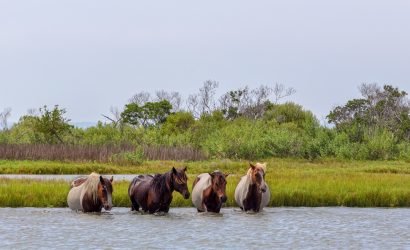Assateague Island was once planned for development. The goal was to develop the entire island to look just like that of Ocean City. Building was slow because there was only a ferry to transport materials back then. By the early 1960’s, roughly 10 homes were built on the island. Then, a bridge was built: the Verrazano. Development of the island picked up after that but the Nor’easter of 1962 wrecked a majority of the homes.
After the storm, folks were reluctant to rebuild or begin building new homes. Several groups of hunters took a risk and built lodges. Some were for profit but most were just used for get-aways. Today, some of these hunting lodges are abandoned and rotting away on the island.
| Assateague is a National Park for a reason – it is meant to be protected. Our local wildlife is meant to be protected and monitored. Our beaches are prime examples of natural barrier islands. Assateague is beaming with natural beauty. These hunters knew this. Assateague was considered a sportsman’s paradise. The beaches and back bays of the island were a magnet to wildfowl hunters and fishermen. Some of the wealthiest men in the area used humble gunning shanties in the marshland, just down a flooded dirt path from their lodge, as shelter in pursuit of ducks and geese. |
.JPG) |
| These individuals made a fine living as hunters on the coast. There are sites and spaces left where you can still see traces of these hunting cabins left behind on the island. Have you ever hiked the Life of the Dunes trail? | Photo of Green Run Hunting Lodge (circa 1965). Green Run Hunting Lodge was used for commercial waterfowl hunting, game hunting, and fishing. Green Run was known as one of the Finest Commercial Clubs in the Country and was one of the best gunning spots in the East. Green Run was considered the largest commercial gunning club in Maryland and was located on Assateague Island. The lodge still remains on the island: broken, abandoned, empty, and nearly standing. Image from the Ocean City Lifesaving Museum. |
The Life of the Dunes trail is located in Assateague National Park at the furthest south point on Bayberry Drive. The trail begins next to the parking lot at the off-roading, drive-on-only beach vehicles area. The Life of the Dunes trail is a ¾-mile loop across the dunes, into the woods, and west to bayside Assateague.
The trail leads to a section of worn down, thick, and partially missing blacktop. This long, narrow stretch of blacktop was once a road; the only road on Assateague Island. Baltimore Boulevard is one of only a few remnants left of life at Assateague before the 1962 storm. This 15-mile road was built by developers in the 1950’s. During the mid ‘50’s, more than 130 side streets were cleared along Baltimore Boulevard. Many of those areas are now unnoticeable; filled in the vegetation over the past 50+ years.
Walking along the Boulevard leads you to a few different clearings. These cleared properties are presumably areas where houses may have once stood. I walked down one path through the wooded marshland. It led me to a dilapidated dock, half submerged in the bay water. I could imagine the type of house that could have been positioned there at one point in time.
|
Some words of wisdom if you plan on hiking the Life of the Dunes trail or venturing into the woods off of the trail:
|
 |
| I did not see any ponies during my 45-minute hike earlier this week. I did see a few deer. They gracefully stood their ground, watched me pass by, and continued munching on some green grasses. The deer are rather used to seeing humans in their habitat, I’m sure. Seeing these creatures made me realize why hunters once populated the island. Assateague is home to a plethora of animals and flourishing wildlife to take advantage of. | Photo of Captain J.W. Quillin (circa 1926). Quillin was a reputable boat captain known for his hunting tours. He took many men, like the one pictured, on hunts for waterfowl and game in the Ocean City and Assateague areas. Image from the Ocean City Lifesaving Museum. |
If you’re looking to explore, learn more about Assateague Island, or go for a nice hike – visit Assateague National Park and spend some time on the Life of the Dunes Trail. Check out the photos in the gallery below and please, take my advice about the bug spray.








